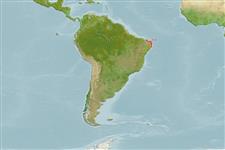Cephalopoda |
Octopoda |
Octopodidae
Environment: milieu / climate zone / गहराई सीमा / distribution range
पारिस्थितिकी
प्रवाल-भित्ति संयुक्त; गहराई सीमा 0 - 45 m (संदर्भ 96968). Subtropical; 35°N - 25°S, 98°W - 9°E (संदर्भ 131170)
Western Atlantic.
Length at first maturity / आकार / Weight / Age
परिपक्व अवधि: Lm 6.0 range ? - ? cm Max length : 12.0 cm ML पुल्लिंग / अलिंग; (संदर्भ 96968); अधिकतम प्रकाशित वज़न: 1.3 kg (संदर्भ 96968)
Total length to 53 cm (Ref. 96968). Common in coastal Northeastern Brazil and its oceanic islands (Ref. 104094). Found on bedrock and gravel, regardless of the presence of algae (Ref. 96968). Also occurs on sand beds, rocky bottoms (Ref. 104094) and crevices on hard substrates (Ref. 104098).
Male and female adults usually die shortly after spawning and brooding, respectively. Mating behavior: Males perform various displays to attract potential females for copulation. During copulation, male grasp the female and inserts the hectocotylus into the female's mantle cavity where fertilization usually occurs (Ref. 833). Spawning occurs in deeper waters (Ref. 104886). Life cycle: Embryos hatch into planktonic stage and live for some time before they grow larger and take up a benthic existence as adults (Ref. 833).
Leite, T.S., M. Haimovici, W. Molina and K. Warnke 2008 Morphological and genetic description of Octopus insularis, a new cryptic species in the Octopus vulgaris complex (Cephalopoda: Octopodidae) from the tropical southwestern Atlantic. Journal of Molluscan Studies 74(1):63-74. (संदर्भ 84317)
IUCN Red List Status
(संदर्भ 130435: Version 2025-1)
CITES status (संदर्भ 108899)
Not Evaluated
CMS (संदर्भ 116361)
Not Evaluated
Threat to humans
Harmless
Human uses
मात्स्यिकी: व्यापारिक
| FishSource |
साधन
अधिक जानकारी
Population dynamicsबाढ़Max. ages / sizesLength-weight rel.Length-length rel.Length-frequenciesMass conversionबहुतायत PhysiologyOxygen consumption
Human RelatedStamps, coins, misc.
इंटरनेट स्रोत
Estimates based on models
Fishing Vulnerability
Low vulnerability (10 of 100).
